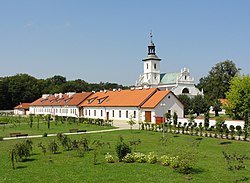Rytwiany
Rytwiany | |
|---|---|
Village | |
 Camaldolese monastery complex | |
| Coordinates: 50°31′45″N 21°12′21″E / 50.52917°N 21.20583°E | |
| Country | |
| Voivodeship | Świętokrzyskie |
| County | Staszów |
| Gmina | Rytwiany |
| Elevation | 178.7 m (586.3 ft) |
| Population (31 December 2009 at Census)[1] | |
| • Total | |
| Time zone | UTC+1 (CET) |
| • Summer (DST) | UTC+2 (CEST) |
| Postal code | 28-236 |
| Area code | +48 15 |
| Vehicle registration | TSZ |
| Website | http://www.rytwiany.com.pl/ |
Rytwiany[2][3][4] [rɨtˈfjanɨ] is a village in Staszów County, Świętokrzyskie Voivodeship, in south-central Poland. It is the seat of the gmina (administrative district) called Gmina Rytwiany. It lies on the Czarna Staszowska river, approximately 5 kilometres (3 mi) south-east of Staszów and 58 km (36 mi) south-east of the regional capital Kielce.[5]
History[edit]
Rytwiany, which belongs to the historic province of Lesser Poland, has a rich and long history. First documented owner of the village was a nobleman named Piotr Bogoria Skotnicki (13th century), and across the centuries, Rytwiany belonged to a number of owners, including Cardinal Wojciech Jastrzębiec, Hieronymus Jaroslaw Łaski, the Lubomirski family, the Potocki family, the Radziwiłł family, and several others.
In 1425–1436, Bishop Jastrzębiec built a defensive Gothic castle in Rytwiany, surrounded by the swamps of the Czarna river. The castle, partly destroyed in 1657 (see Deluge) was inhabited until the 19th century, then fell into a ruin, to be finally demolished in 1859. All that now remains of it is a fortified tower. In the early 17th century, when the village and the castle belonged to the Tęczyński family, it was a cultural center of the region. In 1621, upon request of Jan Tęczyński, Camaldolese monks settled here, building an abbey and a church. The monks moved to Warsaw in 1819, and their church now serves as a local parish church. In the late 19th century, the Radziwiłł family, who were the last owners of the village, built here a palace, which was remodelled in 2005 and now is a hotel.
During the German occupation of Poland (World War II), the Polish resistance movement was active in the village, and Polish underground press was distributed in Rytwiany.[6]
Demography[edit]
According to the 2002 Poland census, there were 1,672 people residing in Rytwiany village, of whom 49.5% were male and 50.5% were female. In the village, the population was spread out, with 23.7% under the age of 18, 37.7% from 18 to 44, 21.2% from 45 to 64, and 17.3% who were 65 years of age or older.[1]
Table 1. Population level of village in 2002 — by age group[1] SPECIFICATION Measure
unitPOPULATION
(by age group in 2002)TOTAL 0-9 10-19 20-29 30-39 40-49 50-59 60-69 70-79 80 + I. TOTAL person 1,672 191 254 248 222 259 184 141 120 53 — of which in % 100 11.4 15.2 14.8 13.3 15.5 11 8.4 7.2 3.2 1. BY SEX A. Males person 828 96 134 128 119 134 97 57 51 12 — of which in % 49.5 5.7 8 7.7 7.1 8 5.8 3.4 3.1 0.7 B. Females person 844 95 120 120 103 125 87 84 69 41 — of which in % 50.5 5.7 7.2 7.2 6.2 7.5 5.2 5 4.1 2.5
Figure 1. Population pyramid of village in 2002 — by age group and sex[1]
Table 2. Population level of village in 2002 — by sex[1] SPECIFICATION Measure
unitPOPULATION
(by sex in 2002)TOTAL Males Females I. TOTAL person 1,672 828 844 — of which in % 100 49.5 50.5 1. BY AGE GROUP A. At pre-working age person 397 207 190 — of which in % 23.7 12.4 11.3 B. At working age. grand total person 985 525 460 — of which in % 58.9 31.4 27.5 a. at mobile working age person 630 330 300 — of which in % 37.7 19.8 17.9 b. at non-mobile working age person 355 195 160 — of which in % 21.2 11.7 9.5 C. At post-working age person 290 96 194 — of which in % 17.3 5.7 11.6
References[edit]
- ^ a b c d e "Local Data Bank (Bank Danych Lokalnych) – Layout by NTS nomenclature (Układ wg klasyfikacji NTS)". demografia.stat.gov.pl: GUS. 10 March 2011.
- ^ Bielec, Jan (ed.); Szwałek, Stanisława (1982). Wykaz urzędowych nazw miejscowości w Polsce. T. III: P – Ż [List of official names of localities in Poland, Vol. III: P – Ż] (in Polish). Ministry of Administration, Spatial Economy and Environmental Protection (1st ed.). Warsaw, Poland: Central Statistical Office.
{{cite book}}:|first1=has generic name (help) - ^ Sitek, Janusz (1991). Nazwy geograficzne Rzeczypospolitej Polskiej [Geographical names of the Republic of Poland] (in Polish). Ministry of Physical Planning and Construction, Surveyor General of Poland, Council of Ministers' Office, Commission for Establishing Names of Localities and Physiographical Objects (1st ed.). Warsaw, Poland: Eugeniusz Romer State Cartographical Publishing House. ISBN 83-7000-071-1.
- ^ "Rytwiany, wieś, gmina Rytwiany, powiat staszowski, województwo świętokrzyskie" [Rytwiany, village, Rytwiany Commune, Staszów County, Świętokrzyskie Province, Poland]. Topographical map prepared in 1:10,000 scale. Aerial and satellite orthophotomap (in Polish). Head Office of Geodesy and Cartography, Poland, Warsaw. 2011. geoportal.gov.pl. Retrieved 27 April 2011.
- ^ "Central Statistical Office (GUS) - TERYT (National Register of Territorial Land Apportionment Journal)" (in Polish). 2008-06-01.
- ^ Gruszczyński, Włodzimierz (2011). Odwet i Jędrusie (in Polish). Zagnańsk. p. 153.
{{cite book}}: CS1 maint: location missing publisher (link)



